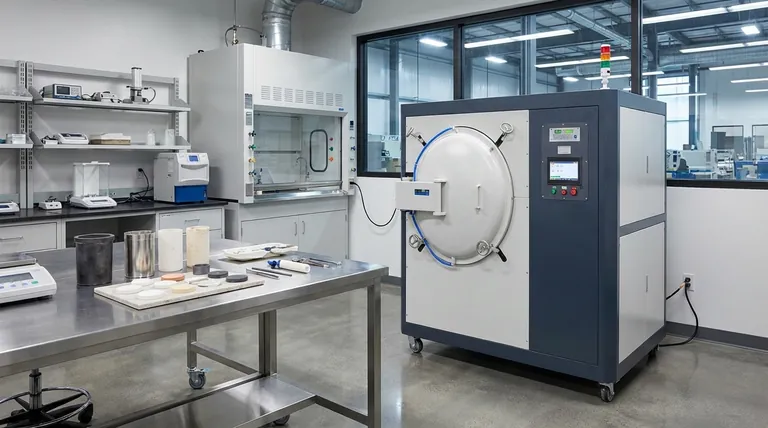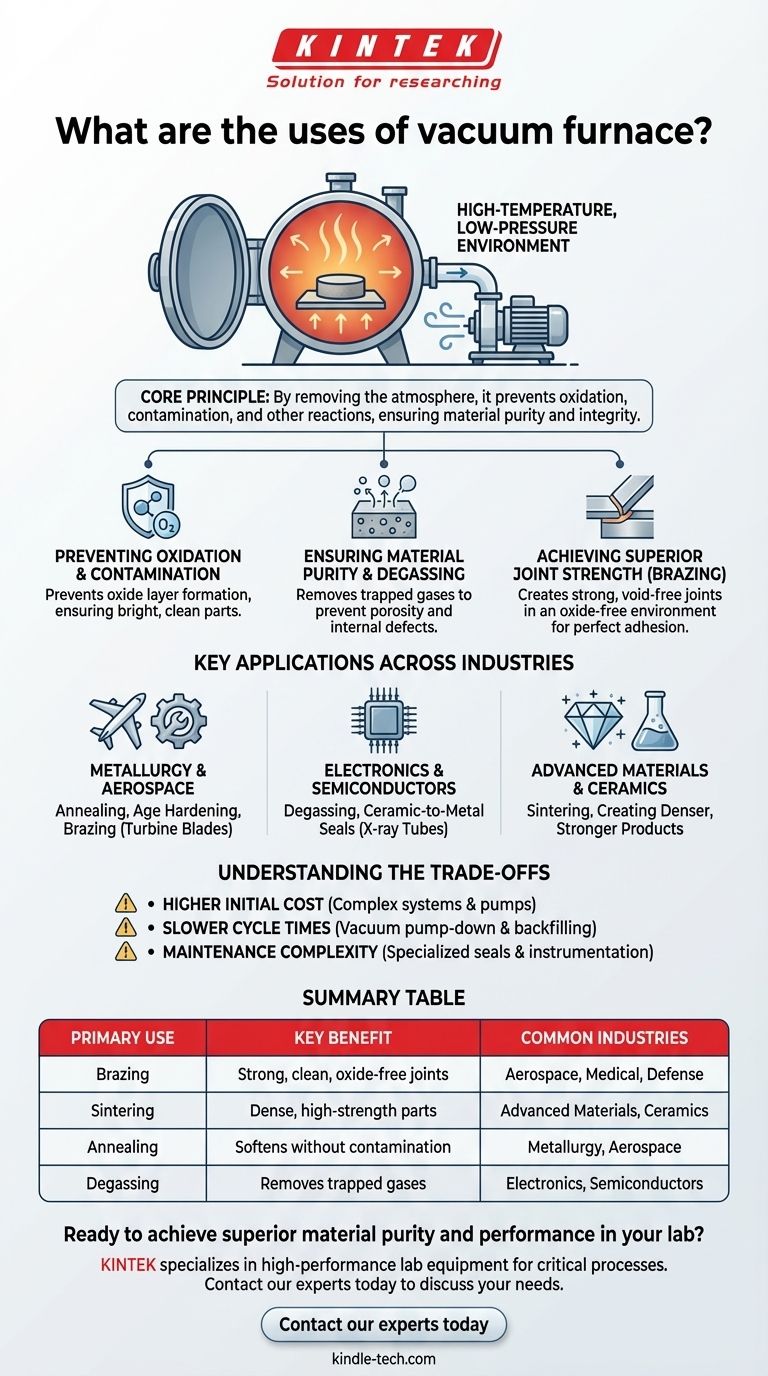In short, a vacuum furnace is a specialized piece of equipment for heat-treating materials in a high-temperature, low-pressure environment. It is primarily used for critical processes like brazing, sintering, annealing, and degassing, where preventing contamination from atmospheric gases like oxygen is essential to the final quality of the product.
The fundamental purpose of a vacuum furnace isn't just to heat materials—it's to heat them in a chemically pure environment. By removing the atmosphere, it prevents oxidation and other reactions that would compromise the integrity, strength, and purity of sensitive metals, alloys, and ceramics.

The Core Principle: Why a Vacuum is Critical
To understand the applications of a vacuum furnace, you must first understand the problem it solves. At high temperatures, materials become highly reactive. An atmospheric furnace exposes them to oxygen, nitrogen, and water vapor, which can cause undesirable chemical changes. A vacuum furnace eliminates this variable.
Preventing Oxidation and Contamination
At elevated temperatures, most metals readily react with oxygen to form an oxide layer on their surface. This is a form of corrosion that can weaken the material, create a poor surface finish, and interfere with subsequent processing steps.
By removing nearly all the air from the chamber, a vacuum furnace ensures that parts emerge from the heat cycle bright, clean, and free of oxides.
Ensuring Material Purity and Degassing
Many materials, especially metals, contain trapped gases from their manufacturing process. When heated, these gases can expand and create porosity or other internal defects, compromising the material's structural integrity.
The vacuum environment actively pulls these trapped gases out of the material, a process known as degassing. This is critical for components used in high-vacuum applications, such as electronics or particle accelerators.
Achieving Superior Joint Strength (Brazing)
Brazing is a process that joins two or more metal items by melting and flowing a filler metal into the joint. The presence of oxides on the base metals can prevent the filler metal from properly wetting the surfaces, resulting in a weak or incomplete bond.
Vacuum brazing creates exceptionally strong, clean, and void-free joints because the process occurs in an oxide-free environment, allowing for perfect adhesion.
Key Applications Across Industries
The ability to create clean, pure, and strong materials makes vacuum furnaces indispensable in several high-tech fields.
Metallurgy and Aerospace
This is the largest area of application. Aerospace components are often made from reactive materials like titanium or high-strength superalloys that cannot be exposed to oxygen at high temperatures.
Key processes include annealing (softening for forming), age hardening, and brazing of critical components like turbine blades and fuel system parts.
Electronics and Semiconductors
The electronics industry relies on vacuum furnaces for manufacturing components that must operate in a vacuum themselves, such as X-ray tubes or vacuum interrupters.
The primary uses are degassing metal parts to ensure they don't release contaminants later and creating strong, hermetic seals between ceramics and metals.
Advanced Materials and Ceramics
Sintering is a process that fuses powdered materials (like powdered metals or ceramics) into a solid mass using heat.
Performing this in a vacuum prevents the formation of unwanted chemical compounds and results in a denser, stronger final product. This is essential for producing high-performance ceramics and specialized metal parts.
Understanding the Trade-offs
While powerful, vacuum furnaces are not the solution for every heat-treating need. Their benefits come with clear trade-offs.
Higher Initial Cost
Vacuum furnace systems, with their required pumps, seals, and control systems, are significantly more complex and expensive to purchase than their atmospheric counterparts.
Slower Cycle Times
A significant portion of the total processing time is dedicated to pumping the chamber down to the required vacuum level and then backfilling it with an inert gas before cooling. This makes them slower than atmospheric furnaces.
Maintenance Complexity
The high-vacuum pumps, seals, and instrumentation require specialized knowledge for routine maintenance and troubleshooting, adding to the operational overhead.
Making the Right Choice for Your Goal
Selecting a vacuum furnace is a decision based on the absolute requirements of the material and the final application.
- If your primary focus is material purity and performance: A vacuum furnace is essential for processing reactive metals or any component where surface oxides or internal gas content would cause failure.
- If your primary focus is high-integrity joining: Vacuum brazing is the definitive choice for creating strong, clean, and reliable joints in critical assemblies for aerospace, medical, or defense applications.
- If your primary focus is cost and high throughput for non-reactive materials: A conventional atmospheric furnace is often the more practical and economical choice for simple heat treatments of common steels and alloys.
Ultimately, choosing a vacuum furnace is a commitment to achieving a level of material quality that is simply not possible in a normal atmosphere.
Summary Table:
| Primary Use | Key Benefit | Common Industries |
|---|---|---|
| Brazing | Creates strong, clean, oxide-free joints | Aerospace, Medical, Defense |
| Sintering | Produces dense, high-strength parts from powders | Advanced Materials, Ceramics |
| Annealing | Softens materials without surface contamination | Metallurgy, Aerospace |
| Degassing | Removes trapped gases to prevent internal defects | Electronics, Semiconductors |
Ready to achieve superior material purity and performance in your lab?
KINTEK specializes in high-performance lab equipment, including vacuum furnaces designed for critical processes like brazing, sintering, and degassing. Our solutions help you prevent oxidation, ensure material integrity, and produce reliable results for aerospace, electronics, and advanced materials applications.
Contact our experts today to discuss how a KINTEK vacuum furnace can meet your specific laboratory needs and enhance your research and production capabilities.
Visual Guide

Related Products
- Vacuum Heat Treat Furnace with Ceramic Fiber Liner
- Vacuum Heat Treat Sintering Brazing Furnace
- Vacuum Hot Press Furnace Heated Vacuum Press Machine Tube Furnace
- Molybdenum Vacuum Heat Treat Furnace
- Vacuum Heat Treat and Molybdenum Wire Sintering Furnace for Vacuum Sintering
People Also Ask
- What materials are used in a vacuum furnace? Selecting the Right Hot Zone for Your Process
- What is a vacuum furnace used for? Unlock Purity in High-Temperature Processing
- What are the advantages of a vacuum furnace? Achieve Superior Purity and Control in Heat Treatment
- What is the maximum temperature in a vacuum furnace? It Depends on Your Materials and Process Needs
- What is the leak rate for a vacuum furnace? Ensure Process Purity and Repeatability



















